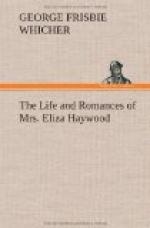The publisher of the letters was William Rufus Chetwood, later the prompter at Drury Lane Theatre, but then just commencing bookseller at the sign of Cato’s Head, Covent Garden. He had already brought out for Mrs. Haywood the first effort of her genius, a romantic tale entitled “Love in Excess: or, the Fatal Enquiry.” We have the author’s testimony that the three parts “mett a Better Reception then they Deservd,” and indeed the piece was extraordinarily successful, running through no less than six separate editions before its inclusion in her collected “Secret Histories, Novels and Poems” in 1725. On the last page of “Letters from a Lady of Quality to a Chevalier” Chetwood had also advertised for speedy publication “a Book entitled, The Danger of giving way to Passion, in Five Exemplary Novels: First, The British Recluse, or the Secret History of Cleomira, supposed dead. Second, The Injur’d Husband, or the Mistaken Resentment. Third, Lasselia, or the Unfortunate Mistress. Fourth, The Rash Resolve, or the Untimely Discovery. Fifth, Idalia, or the Self-abandon’d.[19] Written by Mrs. Eliza Haywood.” During the next three years the five novels were issued singly by Chetwood with the help of other booksellers, usually Daniel Browne, Jr., and Samuel Chapman. This pair, or James Roberts, Chetwood’s successor, published most of Mrs. Haywood’s early writings. The staple of her output during the first decade of authorship was the short amatory romance like “Love in Excess” and the “exemplary novels” just mentioned. These exercises in fiction were evidently composed currente calamo, with little thought and less revision, for an eager and undiscriminating public. Possibly, as Mr. Gosse conjectures,[20] they were read chiefly by milliners and other women on the verge of literacy. But though persons of solid education avoided reading novels and eastern tales as they might the drinking of drams, it is certain that no one of scanty means could have afforded Mrs. Haywood’s slender octavos at the price of one to three shillings. The Lady’s Library ("Spectator” No. 37) containing beside numerous romances “A Book of Novels” and “The New Atalantis, with a Key to it,” which last Lady Mary Montagu also enjoyed, and the dissolute country-gentleman’s daughters ("Spectator” No. 128) who “read Volumes of Love-Letters and Romances to their Mother,” a ci-devant coquette, give us perhaps a more accurate idea of the woman novelist’s public. Doubtless Mrs. Haywood’s wares were known to the more frothy minds of the polite world and to the daughters of middle-class trading families, such as the sisters described in Defoe’s “Religious Courtship,” whose taste for fashionable plays and novels was soon to call the circulating library into being.




